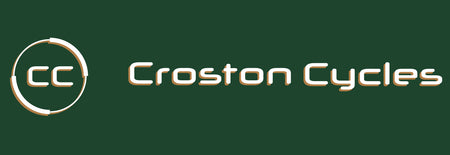
Croston Cycles Bike Fitting Blog - Where's your cleats at?
Welcome to the Croston Cycles Bike Fitting Blog. We offer bike fitting in store and Nick Thomas, our expert and qualified fitter, will be using this blog to share his tips and ensure you maximise your cycling comfort and performance. This week we look at the subject of cleat position and cycling performance.
Cleat Position
We see a wide variety of cleat positions during bike fits but rarely can the cyclist explain why they chose that position. The cleat position determines where the body connects with the bike so is an important factor in how effective power transfer is to the drive chain.
Cleats are designed to provide a stable connection between the pedal and foot. Designs vary between brands but the basic principles still apply: they should be secure, provide adequate float, maximise physical potential and be as comfortable as possible.
Float
Float is the amount of medial and lateral movement the cleats allow the foot to rotate on the pedal. Different cleats provide varying levels of float (including zero float) and can be further controlled by adjusting the tension in the pedals.
Float should enable you to ride naturally with some degree of float either side of your natural foot position. For most people this tends to be the neutral position for both feet but occasionally one - or both - of the cleats needs to be adjusted to provide a more abducted foot position.
If you feel you’re pulling against the end range of cleat movement you’ll most likely experience an uncomfortable twisting feeling in the knee with eventual soreness and muscle tightness down the outside of the thigh. To resolve this rotate the cleat until enough float is provided and the tension is eliminated.
If you feel the foot sliding around while riding consider using a cleat with less float or adjust the tightness on the pedals until the movement is sufficiently reduced.
Position
Most cyclists we see position their cleats under – or in font of – the metatarsophalangeal joint (ball of the foot). Most people have decided on this position by accident but some have done so to provide more leverage around the ankle joint. There are several problems associated with fitting cleats so far forward on the foot:
- There will be limited power generated from the lower leg muscles so a longer lever arm will be of questionable benefit but leads to increased, unnecessary muscular fatigue. The lower leg muscles should be used to maintain power transfer by limiting the amount of dorsiflexion (heel drop) at the bottom of the pedal stroke, often referred to as ‘ankling’.
- If the centre of pressure is directly under the metatarsophalangeal joint it’s common to experience ‘hot spots’ which is irritation within the foot caused by prolonged pressure. This is often felt during very long events, e.g. sportives and Ironman.
- The further forward the cleat position the higher the knee has to lift as the leg passes over the top of the pedal stroke. For someone with good range of hip flexion mobility this isn’t a problem but most people we deal with have varying levels of restriction in the hips and can’t flex their hip sufficiently at the top of the pedal stroke. The result is usually rocking hips to ‘lift’ the leg over the top of the pedal stroke or legs abducting (knees sticking out) to open the hips up sufficiently to bring the knees around the side instead of over the top. Both compensations are inefficient and can lead to discomfort and/or injury.
There is more evidence to suggest a cleat position set further back is more efficient in terms of increasing power transfer, reducing muscular fatigue and improving biomechanical efficiency. For cyclists we usually set the cleats at least 10mm behind the metatarsophalangeal joint to prevent any of the problems described above.
Triathlon-specific
When bike fitting for a triathlete it’s essential to take the running discipline into account. It’s therefore surprising to see how many triathletes have previously been fitted without consideration being given to how the cleat position impacts on the run. Whereas the lower leg muscles are simply required for ankling during the bike, the same muscles are essential when running for propulsion and to maintain biomechanical efficiency. This is especially relevant for people competing at Ironman where biomechanical efficiency already deteriorates substantially as the marathon progresses. In simple terms, over stressing the lower leg during the cycle section will significantly Impact your ability to run.
For anyone competing at Ironman 70.3 or further it’s often appropriate to position the cleats as far back as possible. This enables the athlete to pedal efficiently, reduces fatigue in the calves and lower limb and allows them to effectively off the bike.
Nick Thomas is the resident bike fitter at The Endurance Coach, based at Croston Cycles. He is a fully qualified bike fitter and expert in lower limb mechanics, holding a BSc (Hons) in podiatry. A 90 minute bike fitting session costs £75 and you can contact him using the email address: nickthomas@theendurancecoach.com or see more about his fitting services by GOING HERE.
